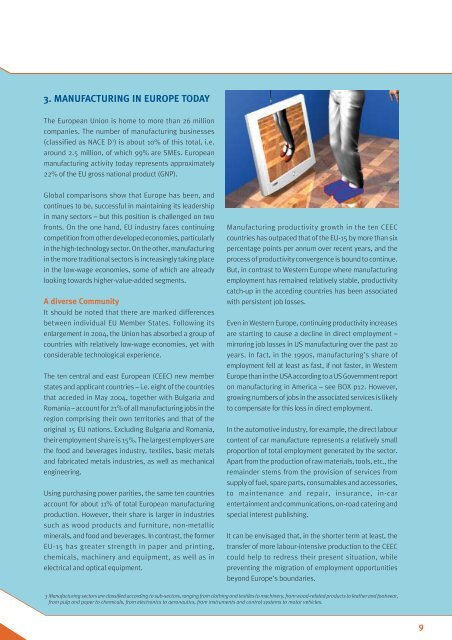MANUFUTURE – a vision for 2020
MANUFUTURE – a vision for 2020
MANUFUTURE – a vision for 2020
You also want an ePaper? Increase the reach of your titles
YUMPU automatically turns print PDFs into web optimized ePapers that Google loves.
3. MANUFACTURING IN EUROPE TODAY<br />
The European Union is home to more than 26 million<br />
companies. The number of manufacturing businesses<br />
(classified as NACE D3 ) is about 10% of this total, i.e.<br />
around 2.5 million, of which 99% are SMEs. European<br />
manufacturing activity today represents approximately<br />
22% of the EU gross national product (GNP).<br />
Global comparisons show that Europe has been, and<br />
continues to be, successful in maintaining its leadership<br />
in many sectors <strong>–</strong> but this position is challenged on two<br />
fronts. On the one hand, EU industry faces continuing<br />
competition from other developed economies, particularly<br />
in the high-technology sector. On the other, manufacturing<br />
in the more traditional sectors is increasingly taking place<br />
in the low-wage economies, some of which are already<br />
looking towards higher-value-added segments.<br />
A diverse Community<br />
It should be noted that there are marked differences<br />
between individual EU Member States. Following its<br />
enlargement in 2004, the Union has absorbed a group of<br />
countries with relatively low-wage economies, yet with<br />
considerable technological experience.<br />
The ten central and east European (CEEC) new member<br />
states and applicant countries <strong>–</strong> i.e. eight of the countries<br />
that acceded in May 2004, together with Bulgaria and<br />
Romania <strong>–</strong> account <strong>for</strong> 21% of all manufacturing jobs in the<br />
region comprising their own territories and that of the<br />
original 15 EU nations. Excluding Bulgaria and Romania,<br />
their employment share is 15%. The largest employers are<br />
the food and beverages industry, textiles, basic metals<br />
and fabricated metals industries, as well as mechanical<br />
engineering.<br />
Using purchasing power parities, the same ten countries<br />
account <strong>for</strong> about 11% of total European manufacturing<br />
production. However, their share is larger in industries<br />
such as wood products and furniture, non-metallic<br />
minerals, and food and beverages. In contrast, the <strong>for</strong>mer<br />
EU-15 has greater strength in paper and printing,<br />
chemicals, machinery and equipment, as well as in<br />
electrical and optical equipment.<br />
Manufacturing productivity growth in the ten CEEC<br />
countries has outpaced that of the EU-15 by more than six<br />
percentage points per annum over recent years, and the<br />
process of productivity convergence is bound to continue.<br />
But, in contrast to Western Europe where manufacturing<br />
employment has remained relatively stable, productivity<br />
catch-up in the acceding countries has been associated<br />
with persistent job losses.<br />
Even in Western Europe, continuing productivity increases<br />
are starting to cause a decline in direct employment <strong>–</strong><br />
mirroring job losses in US manufacturing over the past 20<br />
years. In fact, in the 1990s, manufacturing’s share of<br />
employment fell at least as fast, if not faster, in Western<br />
Europe than in the USA according to a US Government report<br />
on manufacturing in America <strong>–</strong> see BOX p12. However,<br />
growing numbers of jobs in the associated services is likely<br />
to compensate <strong>for</strong> this loss in direct employment.<br />
In the automotive industry, <strong>for</strong> example, the direct labour<br />
content of car manufacture represents a relatively small<br />
proportion of total employment generated by the sector.<br />
Apart from the production of raw materials, tools, etc., the<br />
remainder stems from the pro<strong>vision</strong> of services from<br />
supply of fuel, spare parts, consumables and accessories,<br />
to maintenance and repair, insurance, in-car<br />
entertainment and communications, on-road catering and<br />
special interest publishing.<br />
It can be envisaged that, in the shorter term at least, the<br />
transfer of more labour-intensive production to the CEEC<br />
could help to redress their present situation, while<br />
preventing the migration of employment opportunities<br />
beyond Europe’s boundaries.<br />
3 Manufacturing sectors are classified according to sub-sectors, ranging from clothing and textiles to machinery, from wood-related products to leather and footwear,<br />
from pulp and paper to chemicals, from electronics to aeronautics, from instruments and control systems to motor vehicles.<br />
9

















